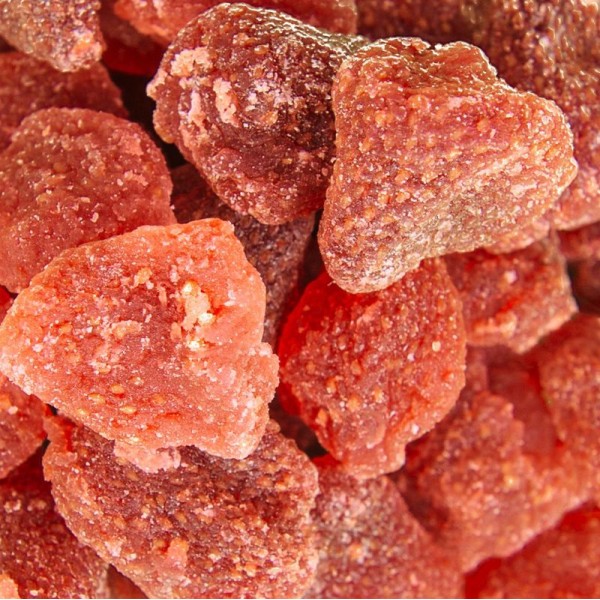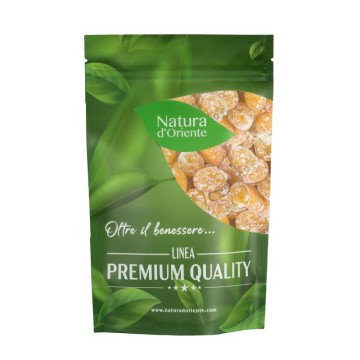Dehydrated strawberries
The delicacy and goodness of strawberries are famous, but these delicious and nutritious fruits don't stay fresh and in season for that long. For this reason, the dehydrated version of the most exquisite strawberries, which can be enjoyed in all seasons, is very popular. Even the benefits for well-being are maintained with drying, let's see what they are.
Dried strawberries: properties and benefits
It is good to add dried strawberries to your diet, as they are cholesterol-free, low in fat, and a variety of beneficial nutrients. Dehydrated strawberries contain some digestive fiber, vitamins and minerals.
They are a rich source of vitamin C , and a fair amount of calcium. Vitamin C is important for boosting the immune system, and among the foods rich in this vitamin, strawberries are an easy and tasty choice.
Remember that the health benefits of strawberries are not entirely affected by the drying of the fruit. The nutrients are maintained, and are often mentioned for the well-being of our organism. Dried strawberries contain, for example, substances such as ellagic acid and some flavonoids that help keep bad cholesterol in the blood low, as well as being powerful natural antioxidants. These fruits are rich in these compounds, which play an important role in reducing inflammation in the body, and help keep cells protected from aging.
This, because the composition of strawberries naturally acts in an anti-aging function, by stimulating the production of collagen - beneficial for the beauty of the skin.
The strawberry therefore has a very high antioxidant power that far exceeds that of other foods and for this reason it is at the top of the special ranking of the USDA (The United States Department of Agriculture) on foods that keep young.
For the well-being of our intestine, dehydrated strawberries contain fibers useful for healthy digestion - sometimes with the right doses, they are used for their laxative, diuretic and purifying (detoxifying) properties.
In addition, they provide a tasty source of minerals such as manganese and potassium. Both play an essential role in regulating normal cell function in the body, and also for heart health.
In addition, strawberries are rich in iron and magnesium, recommended in correct doses for those suffering from rheumatism and are often subject to colds.
The phosphorus content in dehydrated strawberries is also high, as is xylitol - a substance that prevents the formation of dental plaque and kills the germs responsible for bad breath.
Origins and History of cultivation
 The strawberry is a succulent fruit known for millennia, but strawberry plants were not grown in Europe until the Renaissance period.
The strawberry is a succulent fruit known for millennia, but strawberry plants were not grown in Europe until the Renaissance period.
If wild strawberries existed before, they were already very popular in ancient Rome, where they were considered aphrodisiac fruits, used above all for the celebration in honor of Adonis. Legend had it that the tears that Venus shed on his tomb (he was killed out of jealousy by Mars), were identified with strawberries.
Its shape and color, reminiscent of a heart, became its main features in the Middle Ages. The wild strawberry was called "heart fruit", capable of appeasing the passions of love. It seems that at the court of the French kings these fruits of Venus were at the center of love games. The lady invited the knight to the night meeting, eagerly eating strawberries enriched with sugar and cream.
The cultivation of strawberries however began with the gardeners of Louis XIV, who took the wild varieties from the forest to replant them in the gardens of Versailles.
This method remained unchanged until, at the beginning of the eighteenth century, the extra-European species of strawberries arrived, and thus full-cycle cultivation began. It was the eclectic Amédée Frézier, who on a mission picked up white strawberry plants in Chile.
Also in this period, also in France, two American wild species crossed, the Chilean and the Virginia Fragaria, and the “big” strawberry was born, the Fragaria Ananassa that we consume today for its pulpy fruits.
Always used in confectionery, since the Eighties the strawberry has been enhanced through the Nouvelle Cuisine, which by changing the traditional concepts on the associations of flavors and aromas, has used strawberries in an unusual way. A fruit that was lucky too
as an ingredient in risotto and a sweet and sour sauce created to flavor roasts and meat dishes.
Plant and Fruit
The strawberry comes from a plant, of the genus Fragaria, which is part of the rose family - Rosaceae, which produces succulent, red, conical fruits with tiny white flowers.
The genus of strawberry plants is Fragaria and there are over twenty species as well as numerous hybrid strawberries and many varieties of cultivars. The most commonly grown strawberry plant species is Fragaria x Ananassa, or Garden Strawberry.
Plants can last up to 5 years with careful cultivation, but most farmers use them as an annual crop, replanting them every year - also because these plants need fertile soil. Crops take 8 to 14 months to mature.
Strawberries require both a male and a female to produce fruit - which, in reality, are not botanically true fruit. The fruits are the seeds on the surface of the strawberry, the so-called achenes, while what we eat is the aggregate fruit - or false fruit - and the red part is the enlarged receptacle of the flower.
As we have seen, the strawberries commonly grown today are hybrids resulting from the cross between European and American varieties.
Nutritional values of dehydrated strawberries
The useful micronutrients of dried strawberry, as we have seen, are fiber (about 1%), very little fat (1%), a good supply of vitamin C (about 5 mg per 100 g). As a caloric value, 370 Kcal make it an energy food, to be consumed in the correct doses.
Strawberries have a good availability of minerals such as potassium (about 1600 mg per 100 g), iron (about 1.7 mg per 100 g), calcium (about 170 mg per 100 g), manganese and phosphorus.
How to consume dehydrated strawberries in the kitchen or as a snack
Dried strawberries are a versatile fruit that can be used in a variety of ways.
A great way to add them to your diet is to add a portion to your breakfast cereal every morning, or as a snack between meals , during diets.
They are a 'healthy alternative to candy , equally satisfying but with more health properties. In fact, they can also be used before and after sports training as energy snacks.
They are also a gluttonous ingredient for desserts , and can be added to muffins, cakes, cupcakes or ice cream as a top, or to plain yoghurt as an ingredient for flavoring.
They go well ground, such as strawberry powder to add to smoothies, milk or vegetable drinks. They can decorate sweet or savory dishes, aperitifs or cocktails at will.
Dried strawberries: side effects and contraindications
There are no particular contraindications to taking strawberries, but we must consider a possible intolerance or allergy to the food, which is not so rare. In fact, the strawberry contains a certain amount of histamine, which can cause nausea and itching.
As with many dried fruit, dehydrated strawberries have a sugar content such that excessive intake should not be recommended for those suffering from diabetes. Furthermore, being rich in fiber, in abundant doses the strawberry could cause a laxative action on the intestine.
For those who regularly take heart medications, the excessive potassium in strawberries can be harmful to the kidneys, so it is best to not to exceed the regular amounts .













 No reward points for this product.
No reward points for this product.
 The strawberry is a succulent fruit known for millennia, but strawberry plants were not grown in Europe until the Renaissance period.
The strawberry is a succulent fruit known for millennia, but strawberry plants were not grown in Europe until the Renaissance period.














